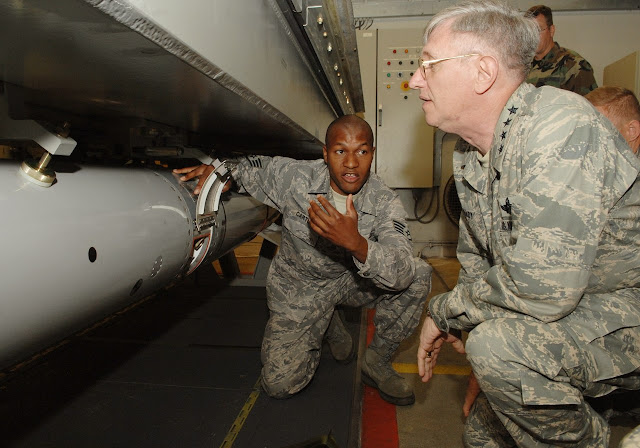F-16s. (Photo courtesy USAF via Wiki)
This it noting the rapidly rising military threat to Australia from nuclear armed China has led to the US's and UK's unprecedented offer of nuclear propelled submarines for Australia. Increasingly aggressive Russia also has a nuclear armed Pacific Fleet. For the medium-long term the US should be persuaded to apply its NATO Nuclear Sharing approach to Australia as a deterrent under AUKUS.
This need not await the operation of Australian SSNs in the 2040s. Under AUKUS Australia is joint researching land and air launched hypersonic missiles with the US and UK. These could mount nuclear shared warheads in the 2030s. Australia and US NASA just happen to be developing ever longer range rocket boosters with ever larger payloads.
The following is to familiarize readers with the long-term-still current NATO nuclear sharing reality. Wiki advises:
"Nuclear sharing is a concept in NATO's policy of nuclear deterrence, which allows member countries without nuclear weapons of their own to participate in the planning for the use of nuclear weapons by NATO. In particular, it provides for the armed forces of those countries to be involved in delivering nuclear weapons in the event of their use.
As part of nuclear sharing, the participating countries carry out consultations and make common decisions on nuclear weapons policy, maintain technical equipment (notably nuclear-capable airplanes) required for the use of nuclear weapons and store nuclear weapons on their territory. In case of war, the United States told NATO allies the Non-Proliferation Treaty (NPT) would no longer be controlling.[1]
Of the three nuclear powers in NATO (France, the United Kingdom and the United States), only the United States is known to have provided weapons for nuclear sharing. As of November 2009, Belgium, Germany, Italy, the Netherlands and Turkey are hosting U.S. nuclear weapons as part of NATO's nuclear sharing policy.[3][4] Canada hosted weapons under the control of the North American Aerospace Defense Command (NORAD), rather than NATO, until 1984, and Greece until 2001.[3][5][6] The United Kingdom also received U.S. tactical nuclear weapons such as nuclear artillery and Lance missiles until 1992, even though the UK is a nuclear-weapon state in its own right; these were mainly deployed in Germany.
Weapons provided for nuclear sharing (2021)[2] | ||
Country | Base | Estimated |
20 | ||
20 | ||
20 | ||
20 | ||
20 | ||
100 | ||
In peacetime, the nuclear weapons stored in non-nuclear countries are guarded by United States Air Force (USAF) personnel and previously, some nuclear artillery and missile systems were guarded by United States Army (USA) personnel; the Permissive Action Link codes required for arming them remain under American control.
In case of war, the weapons are to be mounted on the participating countries' warplanes. The weapons are under custody and control of USAF Munitions Support Squadrons co-located on NATO main operating bases who work together with the host nation forces.[3]
As of 2021, 100 tactical B61 nuclear bombs are believed to be deployed in Europe under the nuclear sharing arrangement.[2] The weapons are stored within a vault in hardened aircraft shelters, using the USAF WS3 Weapon Storage and Security System. The delivery warplanes used are F-16s and Panavia Tornados.[7]"
Pete Comment
For Australia, delivery platforms could begin with 1 to 3 MIRVs MRBMs (boosters large enough are being developed) and our air-to-air refueled F-35As.
